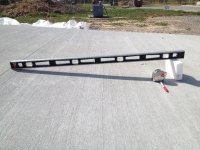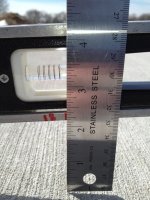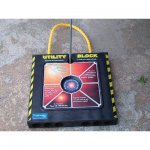Okay, I measured the drop of my driveway today over a distance of 4 feet in order to calculate the slope angle.
Results:
@18": 2-1/8"
@24": 2-13/16
@36": 4-1/16"
@48": 5-1/4"
After measuring, I determined I wanted to build 18" square leveling blocks. However, doing so with 5 4x4s (3.5" wide) across will be 17.5", so that's what I'll use - 17.5" blocks.
I used an online calculator (
link) and it computed my slope at 6.7562 degrees (at 18" out).
So if I use a 4x4, which is 3.5" wide/high, and if I start at zero at the front edge, I guess we'll be cutting it to taper back to 1-3/8 (a difference of 2-1/8") at the back edge. <- Am I on the right track with my thought here?
If I am, then I'd cut 10 ea 4x4s to this same dimension. That's 5 each for the bottom course of 2 blocks (left and right). I like Duane's idea of using 3/4" treated plywood for the top and bottom to tie everything together and have a flat/smooth. This also gives me a finished block (at the front edge) of 5" in height (.75 + 3.5 + .75). Two if these stacked gives me 10"
My coach is leveled out in my garage, so I can't confirm hitch height. Assuming a level tow, I measured/estimated what I think would be the max height from ground to raised bottom of jack pad. I'm thinking this is about 11". With 10" of rise with my 2 courses of blocks, I think I'm going to be good. Plus, I don't know what any of my RV visitors will have for clearance, so 10" will be better. I think what I'll do is cut another 4 ea, 17.5" squares of 3/4" plywood to have ready in case more height is needed and doable.
If I consistently need more height, then I can always attach 1 or more plywood squares to my blocks with screws. When doing so, I'll rotate the orientation of the plywood squares 90 degrees (if I can figure out any direction in it)

Thoughts y'all?
Also - what if I used untreated lumber and painted it? Just as good?
Jim



Oops on the ruler not being level - could change my figure by an 1/8". Not worth setting up and remeasuring though






